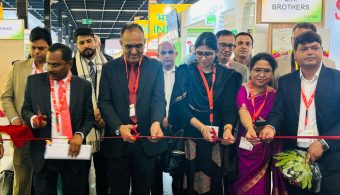Shoba Purushothaman has built her career across seven countries, three startups, and countless reinventions—but one belief has stayed constant: “Success hinges not on what you know, but how you lead, adapt, and communicate.” A former financial journalist turned global entrepreneur, she has sat at the intersection of media, technology, and workforce transformation long before those buzzwords became business imperatives. Today, as co-founder of Hardskills, Shoba is leading a bold charge—to help companies across the world train the human skills that machines can’t replace.
Now based in Berlin and operating across Asia and Germany, she speaks with clarity and conviction about the changing nature of work, the critical gaps in traditional training, and how India and Germany can together shape a globally mobile, future-ready workforce. “The magic happens,” she says, “when German structure meets Indian scale.”
Pooja Chaturvedi Sah from The Dialog converses with Shoba about building companies that matter, why soft skills aren’t soft anymore, and how cross-cultural leadership is the superpower of the future.
From financial journalist to three-time entrepreneur, what drove your shift from journalism to media, tech, and workforce transformation? Was there a turning point that led to founding Hardskills?
As a financial journalist, I had a front-row seat to how digitization disrupted the media industry. Rather than stay an observer, I wanted to actively participate in what became the defining economic and social revolution of our time.
The idea for Hardskills emerged when I realized that as jobs evolved, success would depend on deeply human abilities—creativity, critical thinking, and adaptability. We saw an opportunity to train these at scale in a way that would actually stick and create impact across organizations.
Hardskills targets “hard-to-teach” human skills. What are these, why are they tough to teach through traditional corporate training, and why focus on them in the age of AI and automation?
Hard-to-learn skills include critical thinking, communication under pressure, cross-role collaboration, and embracing change. They’re difficult to teach because they often require unlearning habits, high self-awareness, and real-time feedback—not just lectures or knowledge transfer. At Hardskills, we use immersive, cinematic content, AI-driven roleplays, and cognitive science to help learners practice these behaviors and build lasting habits.
As machines take over routine tasks, what remains essential are human traits—thinking critically, influencing others, and adapting to complexity. Having a workforce that has mastered these skills allows companies to move with agility to bring added value to customers through innovating and leading Change.
Historically, these skills were overlooked or poorly understood. Traditional training often fails because it’s lecture-based, boring, and hard to scale. We address that with a modern, scalable, and science-based approach that engages learners and drives behavior change across entire organizations.
In a tech-driven world, why are human-centric skills like collaboration, empathy, and critical thinking more vital—especially for leadership? Which roles and skills will be in demand?
In today’s world, navigating ambiguity is key. Human-centric skills like empathy, collaboration, and critical thinking are no longer “soft”—they’re core leadership traits. As AI handles technical work, future leaders will be defined by their ability to inspire, make ethical decisions, and respond to diverse needs. These deeply human traits can’t be automated or outsourced.
Roles in demand will sit at the intersection of tech and people: product managers & designers who will be augmented by technology but can exercise creativity and decision making; team leads who can manage large groups of individuals by demonstrating empathy and the ability to motivate; sales & customer relationship roles where the human touch is what makes the difference. The winning talent will be those who can combine domain expertise with the emotional intelligence to drive outcomes in a complex, multidimensional world.
You emphasize “learning that sticks.” What’s missing in corporate training today, and how does Hardskills drive real behavioral change?
Most corporate training is passive, one-size-fits-all, and disconnected from real work. It checks boxes but doesn’t drive change.
We use nine principles from adult learning science to anchor learning in long-term memory. Our pedagogy lodges these skills in the long-term memory of learners. We build experiential journeys where learners actively practice skills, learn over time through spaced repetition, benefit from peer interactions, and AI-based feedback loops to reinforce behaviour over time.
Over 90% of learners apply what they learn within weeks, and we see an average 62% skill improvement in just three months.
What personal experiences—from journalism or entrepreneurship—shaped your belief in the power of human skills for leadership and innovation?
Journalism taught me the value of listening, asking the right questions, and distilling complexity in clarity—foundational leadership skills.
As an entrepreneur, I saw that no matter how strong your strategy or tech is, your success hinges on your ability to collaborate, influence, and adapt.
The best stories and businesses come from people who build trust and lead through change. That’s what led me to co-found Hardskills—to help people scale these “invisible edge” skills.
Working with Fortune 500 firms globally, how do cultural differences shape soft skill training—especially between India and Germany? Can you share examples?
Culture shapes how workplaces operate all over the world. But, when you strip away to get down to what skills are at the core, you will often find there are universal themes that have withstood the test of time.
In India, younger employees often hesitate to speak up, especially in global settings, so we emphasize assertive communication and saying “No” professionally.
In Germany, where communication is direct and structured, the focus is more on adaptability, emotional intelligence, and inclusive leadership in diverse teams.
One German client used our training to help leaders manage multicultural teams across Eastern Europe and Asia. An Indian tech firm used it to boost engineers’ global communication skills and client readiness.
Are you seeing a growing urgency in Germany, India, and the U.S. to invest in soft skills? How are attitudes shifting?
Definitely. In the U.S., companies now recognize that leadership and innovation rely on emotional intelligence and adaptability.
In Germany, skilled labor shortages and growing diversity are pushing employers to prioritize soft skills for retention and leadership.
India’s shift is most dramatic. As it moves from being a cost centre to an innovation hub, companies know that technical ability isn’t enough. Talent must communicate, lead, and deliver globally.
Across the board, soft skills have gone from “nice to have” to “business-critical.” Industry estimates show spending on soft skills training rising from $40B in 2023 to over $60B by 2030.
With Germany facing a skilled labor shortage and India rising as a talent hub, what must young Indians learn to be globally employable—especially in Germany?
To thrive globally, especially in structured environments like Germany, Indian professionals need more than technical skills. They must communicate clearly, take initiative, and understand cultural nuance.
German workplaces value punctuality, precision, and directness—traits that contrast with India’s more flexible communication styles.
We train young Indians to be structured, assertive, and proactive—while staying true to themselves. That’s what global employability means now: combining technical strengths with the soft skills to lead anywhere.
Given Germany’s vocational training strengths and India’s upskilling needs, where do you see room for Indo-German collaboration in building a future-ready workforce?
There’s enormous potential. Germany brings deep expertise in structured, hands-on vocational training, while India has a large, ambitious talent pool eager to skill up for global roles.
The opportunity lies in blending the strengths of both systems. Germany can offer frameworks for quality, discipline, and industry integration, while India can contribute scalability, digital innovation, and adaptability. Combine these two and you can get magic!
At Hardskills, we’re already seeing interest in joint training models, where Indian professionals are trained not only in tech, but also in behavioural skills aligned with German workplace expectations. These kinds of partnerships can create globally mobile talent that’s both technically proficient and culturally agile.
The future-ready workforce will be built on collaboration that goes beyond trade and FDI into manufacturing plants but into joint investment in people. The rise of capability centres and centres of excellence with companies such as SAP unveiling an expansion in Bangalore with another 15,000 employees, and Bosch ramping its engineering hubs all speak to this.
As a global entrepreneur with operations straddling Asia and Germany, how do you compare the Indian and German mindsets, especially in leadership, talent, and innovation?
The Indian and German business mindsets are both strong but approach problems very differently.
Indian businesses are fast, flexible, and entrepreneurial—great for experimentation and rapid growth. But speed can sometimes compromise structure and long-term thinking.
German businesses prioritize process, precision, and planning. Leadership is more formal, decisions are deeply considered, and execution is meticulous. This leads to high quality but does slow down innovation in fast-moving environments which is the norm today.
At Hardskills, we bridge these worlds—drawing on the strengths of both to scale globally. Respecting both cultures has been crucial to building credibility in two of the world’s most important markets.



